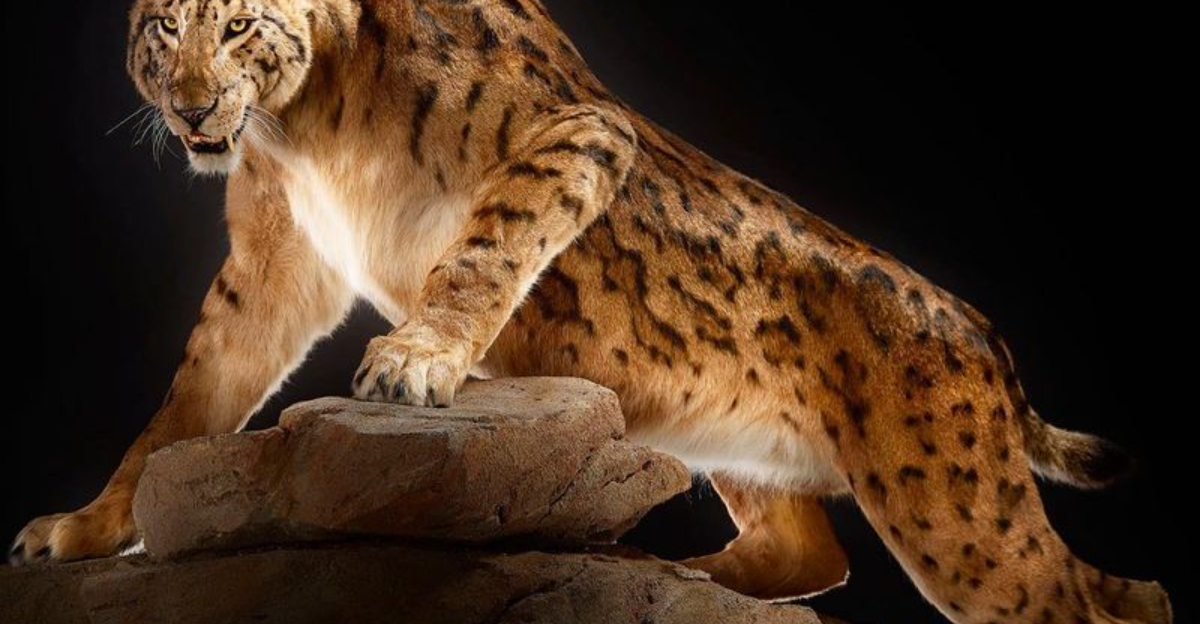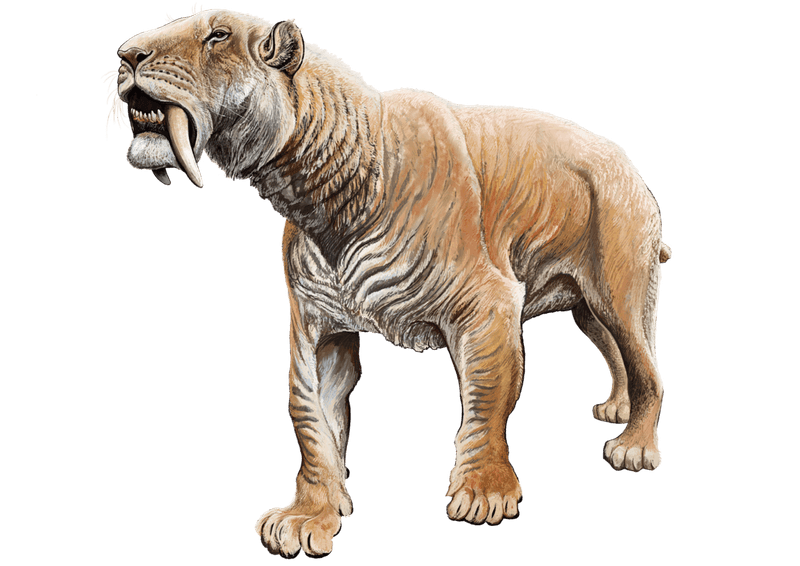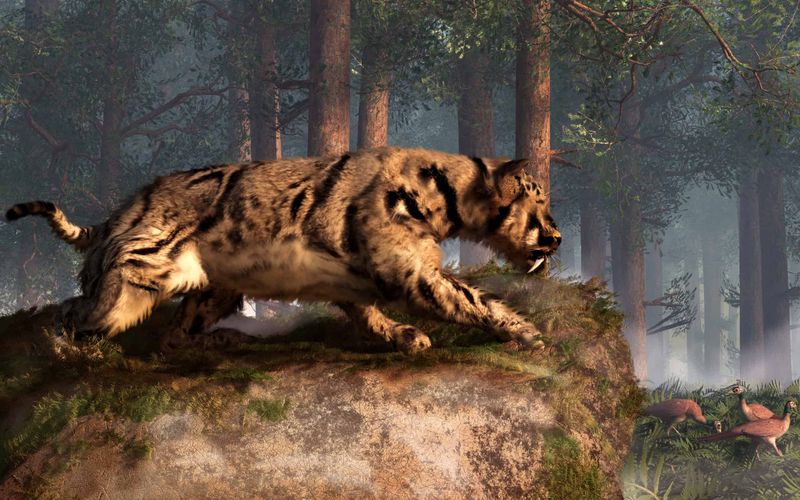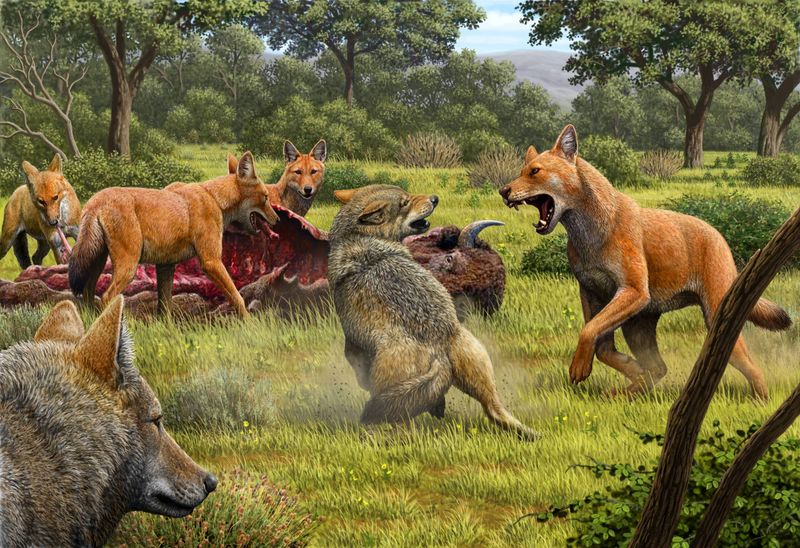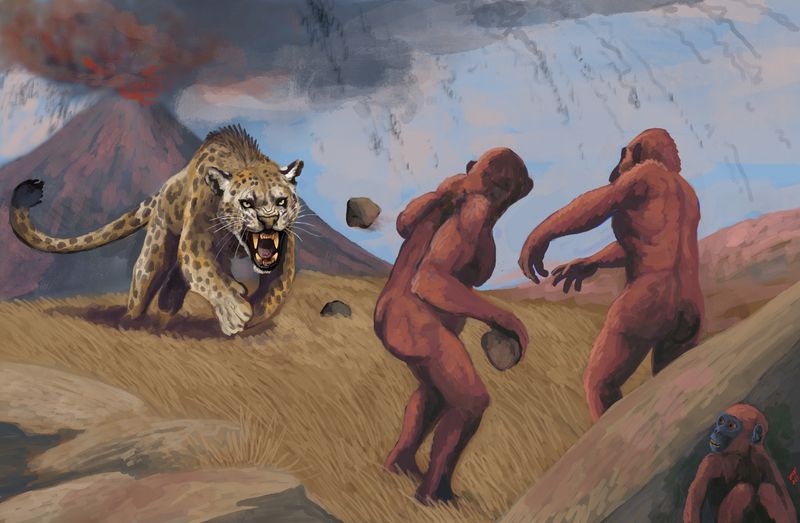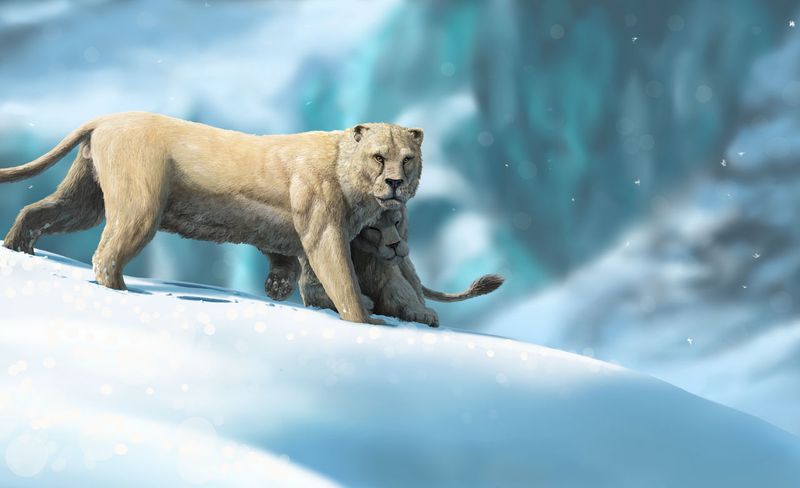Long before we built cities and developed weapons, humans were not the top predators on Earth. Our ancestors lived in constant fear, vulnerable to attacks from creatures with massive jaws, incredible speed, and deadly hunting skills. These extinct beasts viewed early humans as just another meal on the prehistoric menu, creating an environment where survival meant constant vigilance against terrifying predators with appetites for our ancestors.
1. Smilodon: The Iconic Saber-Toothed Killer
Blood-chilling roars and 7-inch fangs made Smilodon the nightmare of early humans. This muscular big cat wasn’t built for long chases but excelled at ambush attacks, leaping from hidden spots to sink those massive canines into unsuspecting prey.
Weighing up to 600 pounds with shoulders more powerful than any modern cat, Smilodon could drag adult humans away with ease. Fossil evidence shows these predators roamed the Americas between 2.5 million and 10,000 years ago, overlapping with human migration into these territories.
2. Megantereon: The Silent Forest Stalker
Shadows among trees became deadly when Megantereon prowled ancient landscapes. Smaller than its cousin Smilodon but equally lethal, this saber-toothed cat specialized in stealth, making it particularly dangerous to early human foragers gathering resources.
Archaeological evidence places Megantereon across Africa, Europe, and Asia—precisely where Homo erectus populations expanded. Unlike modern predators that typically avoid humans, these cats had no learned fear of our ancestors. Their serrated fangs could slice through flesh with horrifying efficiency, making even minor encounters potentially fatal.
3. Crocodylus anthropophagus: The Man-Eating Monster
Named literally as the “man-eating crocodile,” this Tanzanian terror left its mark on human evolution—quite literally. Fossil remains show bite marks on ancient hominin bones, proving these 23-foot reptiles hunted our ancestors.
Water sources became death traps when C. anthropophagus lurked beneath the surface. Unlike modern crocodiles that occasionally attack humans, these prehistoric beasts actively targeted early hominins as preferred prey.
Their massive jaws could crush bones with ease, and their ambush strategy—remaining motionless until the perfect moment to strike—made them nearly impossible to detect until it was too late.
4. Panthera atrox: The American Super Lion
Towering over modern lions by a staggering 25%, Panthera atrox ruled Ice Age North America with unmatched ferocity. Early humans crossing the Bering land bridge faced this apex predator that could bring down bison and mammoths—making humans easy targets.
Fossil evidence suggests these cats weighed up to 800 pounds with paws the size of dinner plates. Their bite force could crush skulls instantly.
Unlike African lions that hunt in prides, researchers believe American lions may have been solitary hunters—silently stalking prey through grasslands and forests, striking with explosive speed that left little chance for escape.
5. Gigantopithecus: The Colossal Ape Threat
Standing 10 feet tall and weighing over half a ton, Gigantopithecus blacki wasn’t technically a predator—but that hardly mattered when it charged. These massive apes shared Asian forests with early Homo erectus, creating terrifying territorial conflicts.
Fossil mandibles reveal powerful jaws designed to crush bamboo and tough vegetation. When threatened, this strength could easily prove fatal to humans.
Imagine encountering an ape twice the size of a gorilla, with arms capable of snapping trees! While primarily plant-eaters, modern great apes occasionally show aggression—scaled up to Gigantopithecus proportions, even defensive reactions would be deadly.
6. Dinofelis: The Hominid Hunter
Nicknamed the “terrible cat,” Dinofelis earned a sinister reputation among paleoanthropologists studying human evolution. Fossil evidence from African caves tells a grim story—hominin skulls bearing puncture wounds that perfectly match this predator’s distinctive fangs.
More agile than Smilodon and equipped with serrated teeth designed for slicing flesh, Dinofelis specialized in medium-sized prey—exactly the size of our ancestors. These cats haunted the same African landscapes where humanity first evolved.
Some researchers even suggest that Dinofelis shaped human evolution by creating selection pressure for larger brains, tool use, and social cooperation—adaptations needed to survive its hunting prowess.
7. Dire Wolf: Pack Hunters of Nightmares
Forget Game of Thrones fantasies—real dire wolves were far more terrifying. Roaming North America until just 9,000 years ago, these predators hunted in coordinated packs that could bring down prey many times their size, including humans venturing into their territory.
Built like tanks compared to modern wolves, dire wolves had massive crushing jaws specialized for breaking bones. Their skull structure suggests they had incredible bite force—over 30% stronger than today’s gray wolves.
La Brea Tar Pits in California preserved hundreds of dire wolf specimens, revealing they often died while attacking trapped prey—evidence of their relentless hunting nature.
8. Pleistocene Leopards: Ancient Ambush Masters
Lurking in the trees above ancient human pathways, Pleistocene leopards were silent killers that struck without warning. Larger and more robust than modern leopards, these Ice Age predators left their mark in the fossil record—and on our ancestors’ bones.
Archaeological sites across Asia and Europe have revealed human remains bearing distinctive leopard tooth marks. These cats were particularly dangerous because they hunted at night when human defenses were weakest.
Unlike other big cats that might drag kills to the ground, leopards hauled their prey—including humans—into trees, away from competing predators. Imagine the terror of early human groups when members simply vanished into the canopy!
9. Homotherium: The Daylight Stalker
Early humans couldn’t even relax during daylight hours with Homotherium on the prowl. Unlike most cats that hunt at night, this scimitar-toothed predator was active during the day, using keen vision to spot prey across open grasslands.
With serrated fangs designed for efficient killing and unusually long front legs, Homotherium could chase down victims with surprising speed. Their distinctive teeth left telling marks on prey bones, including those of ancient humans found in prehistoric sites.
Cave paintings from Europe suggest our ancestors feared and respected these cats enough to record their likeness—a testament to their impact on early human communities.
10. Short-Faced Bear: The Sprinting Giant
Imagine a bear twice the size of a grizzly that could outrun a horse! Short-faced bears dominated Ice Age North America with terrifying speed and size, standing over 11 feet tall when reared up.
These monsters could smell prey from miles away with their enhanced nasal cavities. While primarily scavengers that used their speed to chase other predators from kills, they wouldn’t hesitate to hunt humans if the opportunity arose.
Their long limbs gave them incredible reach, and their massive jaws could crush bones to extract nutritious marrow. For early humans in North America, no cave or shelter was truly safe if a short-faced bear caught their scent.
11. Andrewsarchus: The Mega-Jawed Terror
With jaws spanning an incredible 3 feet, Andrewsarchus represents one of the most frightening mammalian predators ever discovered. Though it lived long before modern humans, this massive wolf-like creature hunted our distant mammalian ancestors.
Standing taller than a man at the shoulder with a skull larger than a horse’s, this monster combined the worst aspects of wolves and big cats in one terrifying package. Scientists estimate it could exert bone-crushing pressure with each bite.
Only one skull has ever been found, leaving much mystery about its behavior—but that massive head tells a clear story of its predatory power.
12. Eurasian Cave Lion: The Ice Age Nightmare
Immortalized in cave paintings by terrified human artists, Eurasian cave lions struck fear into our ancestors across Europe and Asia. Up to 25% larger than modern African lions, these massive cats hunted in the same territories where Neanderthals and early Homo sapiens struggled to survive.
Unlike today’s lions, cave lions likely had no manes but possessed powerful forequarters for taking down giant prey. Their presence shaped human behavior, forcing our ancestors to develop better weapons and hunting strategies.
Frozen specimens discovered in Siberian permafrost revealed these were not just bigger lions—they were specialized Ice Age killing machines.
